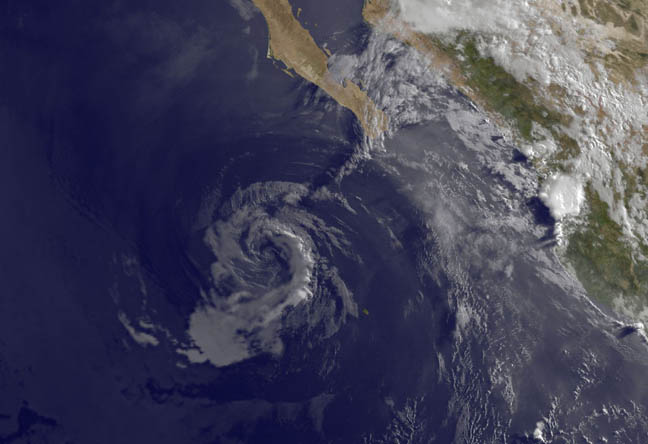A Satellite View: Former Hurricane Cristina Now a Ghost of Its Former Self

NOAA's GOES-West satellite captured this infrared image of Cristina as a remnant low pressure area on June 16 at 9:15 a.m. EDT. Image Credit: NASA/NOAA GOES Project
Convection is rising air that forms the thunderstorms that make up a tropical cyclone and when there is none, there are no thunderstorms to keep it going. That's exactly what happened to Cristina in the Eastern Pacific Ocean on Sunday, June 15.
At 11 a.m. EDT (8 a.m. PDT) on Sunday, June 15, Cristina had weakened to a tropical depression near latitude 20.1 north and longitude 113.3 west, about 290 miles (470 km) southwest of the southern tip of Baja California At that time the depression was moving toward the west-northwest near 6 mph (9 kph) and Cristina's maximum sustained winds had decreased to near 35 mph (55 kph).
Forecaster Brennan at the National Hurricane Center (NHC) noted that “Cristina continues to lack any deep convection, which is not surprising given the hostile environment of strong shear, cool waters and dry air.”
That hostile environment took its toll on Cristina early on June 16 when the NHC declared Cristina a remnant low pressure area. At 09:07 UTC (5:07 a.m. EDT), the post-tropical remnant low pressure area formerly known as Cristina was centered near 21 north latitude and 115 west longitude.
The remnant low had maximum sustained winds near 20 to 25 knots (23 to ~29 mph/37 to ~46 kph) and was generating seas to 8 feet (2.4 meters). As Cristina's remnants continue to dissipate, NHC forecasters expect wave heights to decrease.
Text credit: Rob Gutro
NASA's Goddard Space Flight Center
Media Contact
All latest news from the category: Earth Sciences
Earth Sciences (also referred to as Geosciences), which deals with basic issues surrounding our planet, plays a vital role in the area of energy and raw materials supply.
Earth Sciences comprises subjects such as geology, geography, geological informatics, paleontology, mineralogy, petrography, crystallography, geophysics, geodesy, glaciology, cartography, photogrammetry, meteorology and seismology, early-warning systems, earthquake research and polar research.
Newest articles

High-energy-density aqueous battery based on halogen multi-electron transfer
Traditional non-aqueous lithium-ion batteries have a high energy density, but their safety is compromised due to the flammable organic electrolytes they utilize. Aqueous batteries use water as the solvent for…

First-ever combined heart pump and pig kidney transplant
…gives new hope to patient with terminal illness. Surgeons at NYU Langone Health performed the first-ever combined mechanical heart pump and gene-edited pig kidney transplant surgery in a 54-year-old woman…

Biophysics: Testing how well biomarkers work
LMU researchers have developed a method to determine how reliably target proteins can be labeled using super-resolution fluorescence microscopy. Modern microscopy techniques make it possible to examine the inner workings…





















